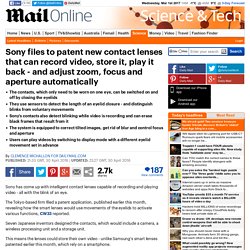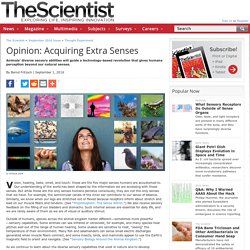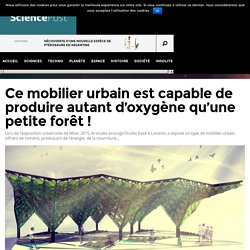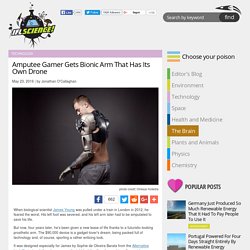

Omega Ophthalmics is an eye implant platform with the power of continuous AR. Turning Plants Into Power Generators Trending. All plants have passageway networks inside of them where water and nutrients travel from one part of the planet to another, and researchers are discovering that these passageways can be harnessed in new and unique ways to benefit mankind.

Among the things that they can be useful for is generating and storing electricity, as a study in the Proceedings of the National Academy of Sciences points out. Can we harness plants to generate electricity for us? Image Credit: Shutterstock All plants naturally absorb sunlight and utilize it to produce both oxygen and energy via photosynthesis, but it may be possible to harness these passageway networks to generate electricity for communities by transforming these internal passageway networks into electrical circuits. To do this, researchers needed to find a way to channel the energy plants produce. Cyborg Roses Could Be Used To Grow Computer Systems. Imagine you could inject a special, electrically conductive fluid into a rose, which then spreads out through the plant and grows into it.

Imagine creating an entire garden or forest of cyborg plants that act as a gigantic, biological computer network. Well, imagine no more – scientists from Sweden’s Linköping University have successfully managed to perform the former, while looking forward to the latter in the future. Sony patent application reveals new contact lenses that can record video. Sony has come up with intelligent contact lenses capable of recording and playing video - all with the blink of an eye.

The Tokyo-based firm filed a patent application, published earlier this month, revealing how the smart lenses would use movements of the eyelids to activate various functions, CW33 reported. Seven Japanese inventors designed the contacts, which would include a camera, a wireless processing unit and a storage unit. Scientists Hook Up Brain to Tablet—Paralyzed Woman Googles With Ease. From time to time, the Singularity Hub editorial team unearths a gem from the archives and wants to share it all over again.

It's usually a piece that was popular back then and we think is still relevant now. This is one of those articles. It was originally published October 25th, 2015. We hope you enjoy it! Artificial Skin Feels the Heat. A team of engineers and researchers at Caltech and ETH Zurich say they have developed an artificial skin capable of detecting temperature changes using a mechanism similar to the one used by the organ that allows pit vipers to sense their prey.

The material could be grafted onto prosthetic limbs to restore temperature sensing in amputees, according to the scientists, who added that it could also be applied to first-aid bandages to alert health professionals of a temperature increase, a sign of infection, in wounds. A paper about the new material will be published in Science Robotics on Wednesday. Microbial Nanowires Make for “Green” Electronics. The inner workings of that new cell phone or tablet could be made from bacteria in the not so distant future, as investigators from the University of Massachusetts Amherst just reported about a new type of natural wire produced by bacteria that could greatly accelerate the development of sustainable "green" conducting materials for the electronics industry.

In the new study, the researchers studied microbial nanowires—protein filaments that bacteria use naturally to make electrical connections with other microbes or minerals. “Microbial nanowires are a revolutionary electronic material with substantial advantages over man-made materials,” explained senior study investigator Derek Lovley, Ph.D., professor of microbiology at UMass Amherst. “Chemically synthesizing nanowires in the lab requires toxic chemicals, high temperatures, and/or expensive metals. The energy requirements are enormous. Until now Dr. Dr. ?articles. Vision, hearing, taste, smell, and touch: these are the five major senses humans are accustomed to.

Our understanding of the world has been shaped by the information we are accessing with these senses. But while these are the only senses humans perceive consciously, they are not the only senses that we have. Ce mobilier urbain est capable de produire autant d'oxygène qu'une petite forêt. Lors de l’exposition universelle de Milan 2015, le studio ecoLogicStudio basé à Londres a exposé un type de mobilier urbain offrant de l’ombre, produisant de l’énergie, de la nourriture et de l’oxygène, et ce en associant des technologies modernes et des particularités naturelles liées aux micro-algues.

Le monde de la recherche est souvent influencé par les lobbys, mais certains projets peuvent être source d’optimisme quant au fait d’abandonner nos modèles obsolètes de production centralisée et polluante. Le studio londonien ecoLogicStudio, en collaboration avec un second cabinet spécialisé, Taiyo Europe, avait dévoilé son projet Canopéee Urbaine Algae après six années de travail. Sa forme rappelle alors celle de la canopée, qui n’est autre que l’étage supérieur de la forêt, directement influencé par le rayonnement solaire. Il s’agit ici de fusionner les technologies digitales et les micro-organismes pour construire des structures intelligentes d’un nouveau genre. New Robot Stingray Is Part Biological — It's Powered by Living Heart Cells.
Researchers at Harvard University have created a biohybrid stingray.

No larger than the average coin, the ray contains both biological and artificial parts—rat heart cells grown on a silicon mold fitted over a 3D printed gold skeleton. And it can move. Using a technique called optogenetics, the heart cells are genetically modified to contract when they’re hit with a beam of light. Watch how it's done: Amputee Gamer Gets Bionic Arm That Has Its Own Drone. When biological scientist James Young was pulled under a train in London in 2012, he feared the worst.

His left foot was severed, and his left arm later had to be amputated to save his life. Revolutionary Brain Implant Restores Hand Movement In Quadriplegic Patient. For many, paralysis or limb loss is a lifelong burden, and scientists across the world have been working around the clock to restore movement to these unfortunate few. Now, a new Nature study showcases what is not just a step but a leap forward in medical science.
A young man, who became a quadriplegic during a diving accident, is today able to grasp objects and even play video games using his own hand and fingers, after a novel device was surgically inserted into his brain. This remarkable breakthrough, spearheaded by researchers at The Ohio State University (OSU) Wexner Medical Center, promises to revolutionize the way paralysis is treated in the future. “This is the first technique of its kind,” study co-author Chad Bouton of the New York-based Feinstein Institute for Medical Research told IFLScience. Samsung Has Patented An Augmented Reality Smart-Contact Lens. Google Glass perhaps didn’t receive the earth-shattering response the company – and world – had expected.
However, a proposal that Samsung appears to have in the works could be the augmented reality wearable tech everybody is holding out for. It looks like the Korean tech giant has been thinking about creating the world’s first "smart" contact lenses, able to take photographs with the blink of an eye, technology blog Sammobile reports. Samsung has filed a patent in South Korea for a smart contact lens fitted with a camera and image display. In addition, it will feature sensors that can control certain functions simply by blinking. Homepage Cybathlon – CYBATHLON Championship for Athletes with Disabilities. Labmanager. Video showing the bio-bots' assembly and walking courtesy of the University of Illinois. CHAMPAIGN, Ill. — A new class of miniature biological robots, or bio-bots, has seen the light–and is following where the light shines.
The bio-bots are powered by muscle cells that have been genetically engineered to respond to light, giving researchers control over the bots’ motion, a key step toward their use in applications for health, sensing, and the environment. Led by Rashid Bashir, the University of Illinois head of bioengineering, the researchers published their results in the Proceedings of the National Academy of Sciences. This Remarkable Robot Hand Is Worthy of Luke Skywalker. Most of today's robot hands can perform easy tasks. They’re uber-practical grippers, simple and useful. But is it really so much to ask for robotic masterworks as dextrous as Luke Skywalker’s bionic hand in Star Wars?
In short, yes, yes it is. It might have been a long time ago in a galaxy far far away—but most Star Wars tech is beyond us. Blind Woman Receives Bionic Eye, Reads a Clock With Elation. Recently, the BBC broadcast the reaction of Rhian Lewis, a 49-year-old blind mother of two, as she read a clock correctly using her right eye for the first time in 16 years. Lewis was understandably emotional, and as the first patient in the UK to receive one of the world’s most advanced bionic eye implants—it was one for the books. At the age of five, Lewis was diagnosed with retinitis pigmentosa, a condition that impairs the light-detecting cells—known as photoreceptors—in the retina, making it unable to absorb and process light.
From the condition, Lewis’s right eye is completely blind and her left eye has next to zero vision. Though the condition has no cure in the traditional sense, Lewis’s optic nerve and the brain circuitry necessary for vision have remained undamaged. The photoreceptors, then, are the only elements needing replacement. Scientists Develop World's First Cyber Plant. A team of scientists at Linköping University in Sweden have developed the first electrically augmented plant, creating both analog and digital circuits inside a living rose. This technology could allow scientists to regulate growth and chemical processes in plants, as well as harness photosynthesis to create new solar cells. DARPA's New Prosthetic Hand Lets Paralyzed Man "Feel" Sensations.
What Does The World Look Like For Someone With A Bionic Eye? Remember that amazing story where a British man’s central vision was restored with a bionic eye implant? British Man Receives Bionic Eye Implant. In a world first, an 80-year-old British man has received a bionic eye implant to treat age-related macular degeneration (AMD). Researchers Have Developed A Stretchable Loudspeaker. World's Most Lifelike Bionic Hand Developed. Paralyzed Woman Flew A Fighter Jet Simulator Using Her Thoughts. Remote-Controlled Cyborg Cockroaches Could Save Lives. Scientists Develop Telescopic Contact Lenses That Can Zoom 3X. 'Cyborg' spinal implant could help paralysed walk again.
Cœur artificiel : la seconde implantation se passerait mieux. Amputee Simultaneously Controls Two Robotic Prosthetic Limbs With His Thoughts. Mantis shrimps can see cancer, and scientists have now created a camera that does the same. Scientists Put A Worm's Mind Into A Robot's Body. Smart Artificial Skin Could Give Prosthetic Limbs Feeling. Aimee Mullins: My 12 pairs of legs. Tal Golesworthy: How I repaired my own heart. Cockroach Cyborgs Could Help Rescue Crews After Disasters. Hugh Herr: The new bionics that let us run, climb and dance. VIDEO. Le bras artificiel contrôlé par la pensée... deux ans après.
Watch A Man See For The First Time In 33 Years, Thanks To His New Bionic Eye. Artificial Spleen ‘Cleans’ Blood of Pathogens. Robotic Arms and Hands That Can Feel. The Bionic Eye. News Highlights:Squid Skin Protein May Charge Up Bioelectronic Devices. News Highlights:Google Smart Lens Technology Licensed by Novartis. New Finger Device Reads Books To The Blind. Novel Therapy Allows Paraplegic Patients To Regain Voluntary Movement. Using 3D Printing and Design To Change the Way We Look at Disability. Sci-Fi Style Prosthetic Arm Wins FDA Approval. Wireless Charger Could Power Implants. 3D Printed Device Detoxifies Blood Like a Liver. Intelligence™: Patentability of 3D-Printed Organs. Avec le masque Eidos, la vue et l’ouïe deviennent surhumaines. Google Seeks to Integrate Cameras Into Contact Lenses.
Tough Snail Shell Could Inspire Better Body Armor. États-Unis : Un œil bionique implanté pour la première fois sur des patients. Science sans limite : la grossesse extérieure au corps humain bientôt réalisable. Electronic Skin Can Store Data and Deliver Drugs. A Woman Has Been Given A New 3D Printed Skull. Witness A Deaf Woman Hear For The First Time. Logical Circuits Created With Slime Molds. Transfection Optimization for Improved Efficiency and Performance - The Cell Culture Dish - The Cell Culture Dish. 3D Printed Airway Saves Toddler’s Life. Des muscles artificiels en fil de pêche. Revolutionary membrane can keep your heart beating perfectly forever. 9 Implants that make human healthy body even more useful. Paralysés : bientôt des neuroprothèses pour restaurer le mouvement. Prosthesis Re-creates Sensation of Touch. Une prothèse rend le sens du toucher à un homme amputé de la main.